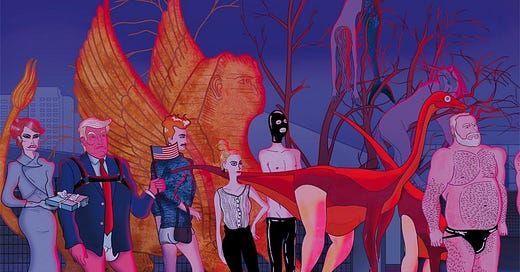#5 Want to get into Berghain? Try psychoanalysis.
What exclusive German nightclubs can teach us about how to choose a therapist.

Hello friends,
Berghain (pronounced Berg-HINE) is a notorious, techno-fuelled, sex-den, alternate-universe, highly exclusive nightclub in Berlin. It has a reputation of mystical proportions, due in part to its firm no-photo policy and crazy opening hours (from midnight Saturday until 4AM Monday morning).
It’s really hard to get in. Well, so I hear. Trying to get into nightclubs in Berlin is not one of my current interests.
It is, however, an interest of many people, who have gathered online to compare notes, trying to crack the secret formula. Despite the entry criteria to the club being what Nick Paumgarten of the New Yorker called “obstinately imprecise”, the online community persists. Journalists publish articles featuring photos of the outfit they wore that got them in, and Berlin hostels share ten tips to get into the club on their websites, including advice like “keep calm”, don’t try and cut the line, and most iconically, wear black. I much preferred this hilarious illustrated guide.
This was all brought to my attention many years ago by my younger brother, who is much cooler than me and much more interested in getting into edgy places. We were chatting about it this week as he prepared for a weekend trip to Germany. He said this:
“You know, the first time I went, I Googled ‘how to get into Berghain’ and I did what it said and wore all black. And I did not get into Berghain. The next time, I thought “I’m just going to wear my favourite clothes.” And they let me in.”
I really can’t think of a better way to summarise one of the most central initiatory lessons in how to be a person. While I’m sure adopting the ‘keep calm and wear black’ strategy does actually ‘work’ for some people, I think my brother’s experience speaks to a greater truth, one that illuminates some things we might also consider when thinking about psychotherapy.
But before we get to that, I have to tell you about this guy.

Sven Marquardt has been the doorman and ‘chief sorter’ at Berghain since it opened in 2004. He doesn’t seem like the sort of man who would ever think to Google anything, much less anything to do with how to be cool. My favourite quote from his fascinating 2015 interview with GQ, when he was asked about the whole “how to get into Berghain” internet fixation, was:
First, let me say I don’t read that kind of stuff. Myself, I only started using the Internet three years ago. Up until then people had to fax me.
People had to fax me. Honest to God. 😂
Anyway, Marquardt (61) was born and raised in Berlin. As an emerging photographer, he captured the punk and anarchist movements that grew around the fall of the Berlin Wall, and he was at the birth of the gay club scene in the city in the early 90s. All of that to say, he is the real deal.
In the GQ article, he (begrudgingly) offered only one comment about getting into the club:
“It’s subjective. Only a few of my guys are allowed to select guests at the door. They have to understand what Berghain is all about first, and I try to give them that foundation. Beyond that, there are no set rules.”
A cynic might frame this as a deliberate ambiguity, designed to contrive mystery and intrigue to increase popularity, but when Marquardt speaks about defending what Berghain is all about, I think he speaks to the real reason the club is so popular - it is a refuge in which to express one’s genuine, weird, visceral, uninhibited, marginalised, sexual self. As such, its inhabitants could only be chosen by feeling - a felt sense of the kind of naturalness required to preserve the atmosphere of such a place. If you want to create a place where people feel safe to be real, it has to be full of real people.
So getting into Berghain, like life, has no set rules. It cannot have set rules without losing its true nature. In a such situation, and in such a world, with no real operating manual to be found, we’re faced with what I’ve come to see as two main options for how to navigate life: we replicate what seems to have worked before, or discover what works for us.
With replication, we can draw data from what has already happened and try to copy those who have had success, a la howtogetintoberghain.com. A therapist operating from this framework might support patients by offering specific strategies, teaching them to replicate what theorists have concluded constitutes a healthy, mentally well person - for example, someone rational, who has positive thoughts and engages in certain behaviours. In the same way that it was noticed over time that the people who wear black might be more likely to get into Berghain, psychologists noticed that depressed people, for example, are more likely to have negative thoughts. The logic then goes, replace the negative thoughts, decrease the depression. Wear fewer colours, get in.
Discovery, by contrast, operates on the basis that each person has a particular design or true nature, that they must uniquely discover and cultivate. Health (as well as creativity, success, vitality and admission to mysterious techno sex dens) comes from the restoration and expression of that particular, strange, real self. This can occur in therapy through engagement in a real and transformational emotional relationship with a therapist, and through an examination of the experiences in one’s life that lead to the impairment of one’s capacity to recognise and express their real self. This therapy helps you figure out how to find your favourite clothes.
As I shared in some detail recently, I was trained in replication, but have come to firmly land in the discovery camp, which has a natural home in the framework of psychoanalysis. I approach my work this way for many reasons, but most of all because it seemed to me that any place worth going has a Sven Marquardt out the front - someone real (and a little bit scary), who has a grand master-level bullshit radar.
To go to places where everyone is pretending, we must learn to pretend. Many of us arrive in therapy as expert pretenders, having been raised in environments where pretending was the best way to survive, and the only way to procure the love and care we longed for. But to go to the real places, where the real people are and the real things are happening, we cannot pretend to be real. We must be real. For lifelong pretenders, this requires some work. If you’re looking for a therapist or a coach (or even looking to get into exclusive ambiguous nightclubs), you will likely be better off finding someone who gives you a feeling that they can help you to be who you really are, rather than someone who wishes to teach you a formula for being a certain kind of way. Otherwise, you will exhaust yourself adhering to that formula forever, pretending forever, while your real self calls out to you from the darkness.
Discovery is much harder, and takes much longer. To put on your favourite clothes, you have to know who you are and what you like and to trust your own discernment over the fray of voices shouting about what’s cool or correct. You also have to have the capacity to find, choose, pay for and take care of said clothes, no small undertaking in itself. While it’s more complex, the real gift of this process is that once you have acquired this awareness and self-trust (and those clothes), you can move more naturally around the world, as yourself, forever, receiving greater and greater dividends over time. This earned naturalness does not require any ongoing rule-following, policing or the implementation of strategies, but relies instead on the restored function of feelings and instincts as guides. I have also seen that those who possess it develop a certain quality about them, that felt sense which tends to magnetise good fortune.
I think that is what got my brother into Berghain.
In love, and the pursuit of a shared path to a greater truth,
Kate





